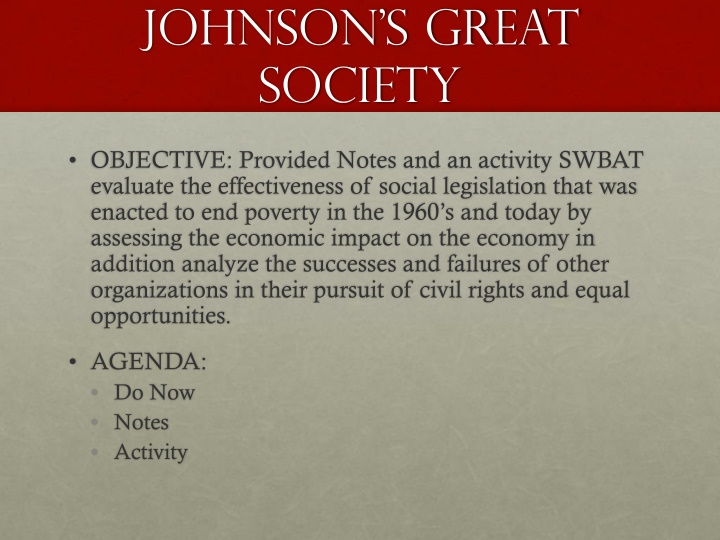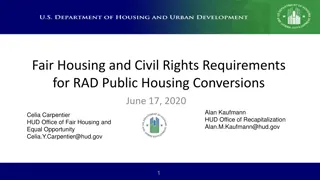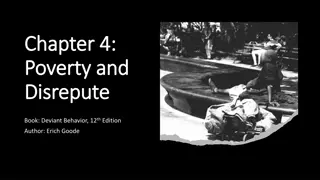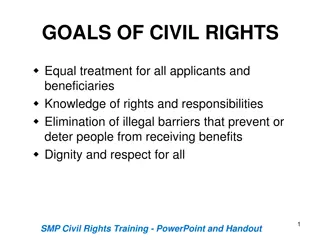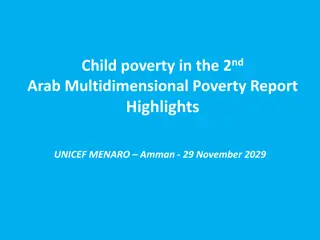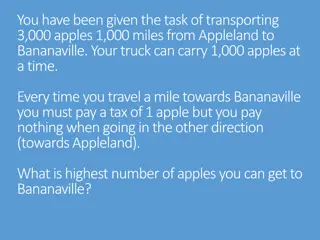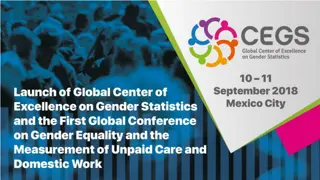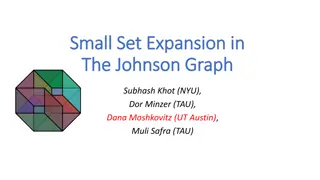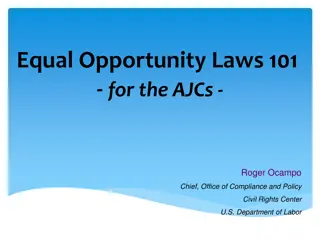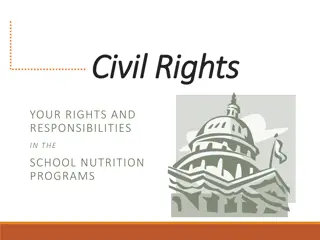Analyzing the Impact of Johnson's Great Society Programs on Poverty and Civil Rights
President Lyndon B. Johnson's Great Society initiatives of the 1960s aimed to tackle poverty, racial injustice, and inequality through various domestic programs. This era saw significant advancements in areas such as education, healthcare, environmental protection, and consumer rights. By evaluating the economic impact and assessing the effectiveness of social legislation then and now, one can analyze the successes and failures of organizations in their pursuit of civil rights and equal opportunities.
Download Presentation

Please find below an Image/Link to download the presentation.
The content on the website is provided AS IS for your information and personal use only. It may not be sold, licensed, or shared on other websites without obtaining consent from the author.If you encounter any issues during the download, it is possible that the publisher has removed the file from their server.
You are allowed to download the files provided on this website for personal or commercial use, subject to the condition that they are used lawfully. All files are the property of their respective owners.
The content on the website is provided AS IS for your information and personal use only. It may not be sold, licensed, or shared on other websites without obtaining consent from the author.
E N D
Presentation Transcript
Johnsons Great society OBJECTIVE: Provided Notes and an activity SWBAT evaluate the effectiveness of social legislation that was enacted to end poverty in the 1960 s and today by assessing the economic impact on the economy in addition analyze the successes and failures of other organizations in their pursuit of civil rights and equal opportunities. AGENDA: Do Now Notes Activity
Johnsons great society Do Now Read the Great Society Speech President Lyndon B Johnson gave at the University of Michigan in 1964 What type of document is this and who is the audience? What is the message of this document?
The Great Society President Lyndon Johnson
GREAT SOCIETY The Great Society was a set of domestic programs in the United States promoted by President Johnson and fellow Democrats in Congress in the 1960s. Main goals of the Great Society: elimination of poverty and racial injustice, improve education, healthcare, environment, cultural centers, transportation, consumer protection, and public broadcasting New major spending programs that addressed these areas were launched during this period The Great Society was an extension of FDR s New Deal
The New Deal was a response to the severe financial and economic crisis of the Great Depression focusing on what historians call the three R s: Relief, Recovery Reform Relief for the unemployed and poor, recovery of the economy to normal levels, and reform of the financial system in hopes of preventing another great depression
JFK attempted to pass legislation dealing with health care, civil rights and poverty only to be cut down by Congress He did pass legislation dealing with space race, labor practices, housing, and unemployment President Johnson took it above and beyond with his Great Society Johnson was able to pass much of the legislation JFK proposed, on topics like, healthcare, civil rights, immigration, ect.
Examples of programs started under the Great Society Economic Opportunity Act create the Job Corps to train young workers Created VISTA Volunteers in Service to America help the poor, poverty stricken Stared Medicare medical care for the aged 65 over Also included Medicaid provided medical services to the poor and disabled, not yet receiving Social Security Immigration and Nationality Act 1965 altered America s quota system on immigration
1965 Elementary and Secondary Education Act aid schools in poor communities Created Head Start pre-school for the poor Johnson s spending on these programs and several others, started our government on a skyrocketing deficit that continues out of control.
Latinos in the early 1960 s More than 900,000 Latinos lived in the United States in 1960. A Latino is any person of Latin American descent. One-third of Mexican American families lived below the poverty line and twice as many Mexican Americans as white Americans were unemployed. Latinos faced discrimination in education. Schools had less qualified teachers, fewer resources, and shabbier facilities. Few teachers were able to speak Spanish. In politics Latinos had far less power than the size of their population warranted. Electoral district boundaries kept Latino votes scattered. The number of Latinos in political office was very small. Latinos were often excluded from serving on juries. Latinos sought social justice the fair distribution of advantages and disadvantages in society.
La Raza Jos Angel Guti rrez formed La Raza Unida (RUP) ( the united people ) political party Campaigned for bilingual education, improved public services, education for children of migrant workers, and an end to job discrimination Main Goal = bilingual education RUP candidates were elected to offices in several Texas cities. RUP expanded into Colorado and other parts of the Southwest. Disagreements among RUP leaders caused the party to fall apart in the late 1970s.
The Peace Corps In 1961, President John F. Kennedy established the Peace Corps to promote world peace and friendship. Three simple goals comprise the Peace Corps mission: Helping people of interested countries in meeting their need for trained men and women. Helping promote a better understanding of Americans on the part of the peoples served. Helping promote a better understanding of other peoples on the part of all America
American Indian Movement (AIM)Native American rights organization Native Americans Seek Greater Autonomy Many Native Americans cling to their culture, refuse assimilation Native Americans poorest group, most unemployment, health problems Termination policy relocates, does not solve problems Termination did not help Native Americans mainstream, just forced them to change Native Americans call for economic opportunities on reservations 1968 LBJ establishes National Council on Indian Opportunity
American Indian Movement (AIM)Native American rights organization Main goals: Renew Traditional Culture Economic independence Better Education
Enviormental Concerns DDT was developed as the first of the modern synthetic insecticides in the 1940s. It was initially used with great effect to combat malaria, typhus, and the other insect-borne human diseases. It also was effective for insect control in crop and livestock production, institutions, homes, and gardens. DDT's quick success as a pesticide and broad use in the United States and other countries led to the development of resistance by many insect pest species. (epa.org) June 1962: "Silent Spring Rachel Carson s Silent Spring is published. Acclaimed as the catalyst of the modern environmental movement, Silent Spring condemns the overuse of pesticides. Between 1950-1962 the amount of DDT found in human tissue had tripled.
After the chemical industry denounces Carsons book as a gross distortion of actual facts, President John F. Kennedy charges his Science Advisory Committee to review the book s claims. The Committee reports that the conclusions in Silent Spring are generally correct, and by 1972 DDT will be banned in the U.S. adverse environmental effects, such as those to wildlife, as well as its potential human health risks. Since then, studies have continued, and a relationship between DDT exposure and reproductive effects in humans is suspected, based on studies in animals. In addition, some animals exposed to DDT in studies developed liver tumors.
